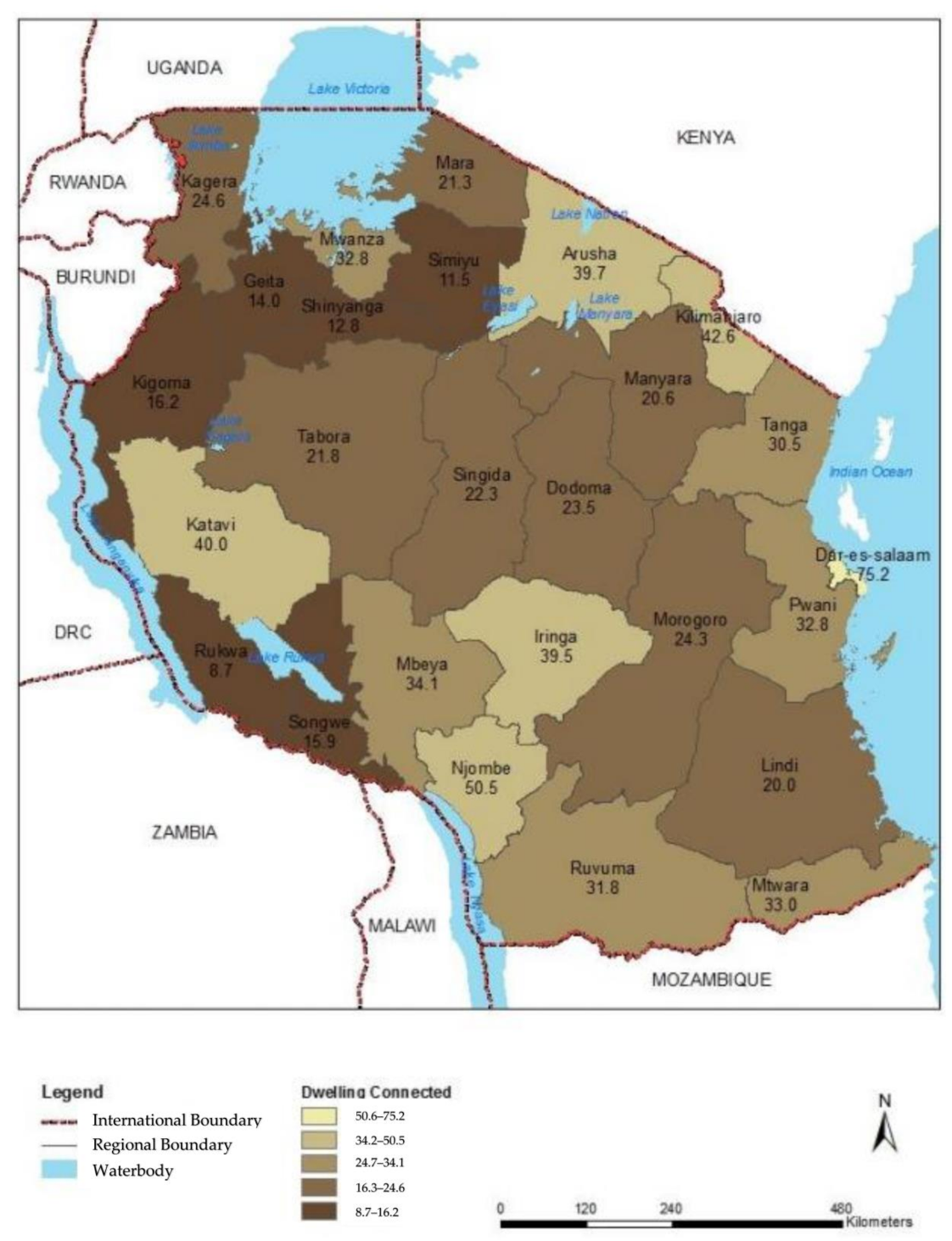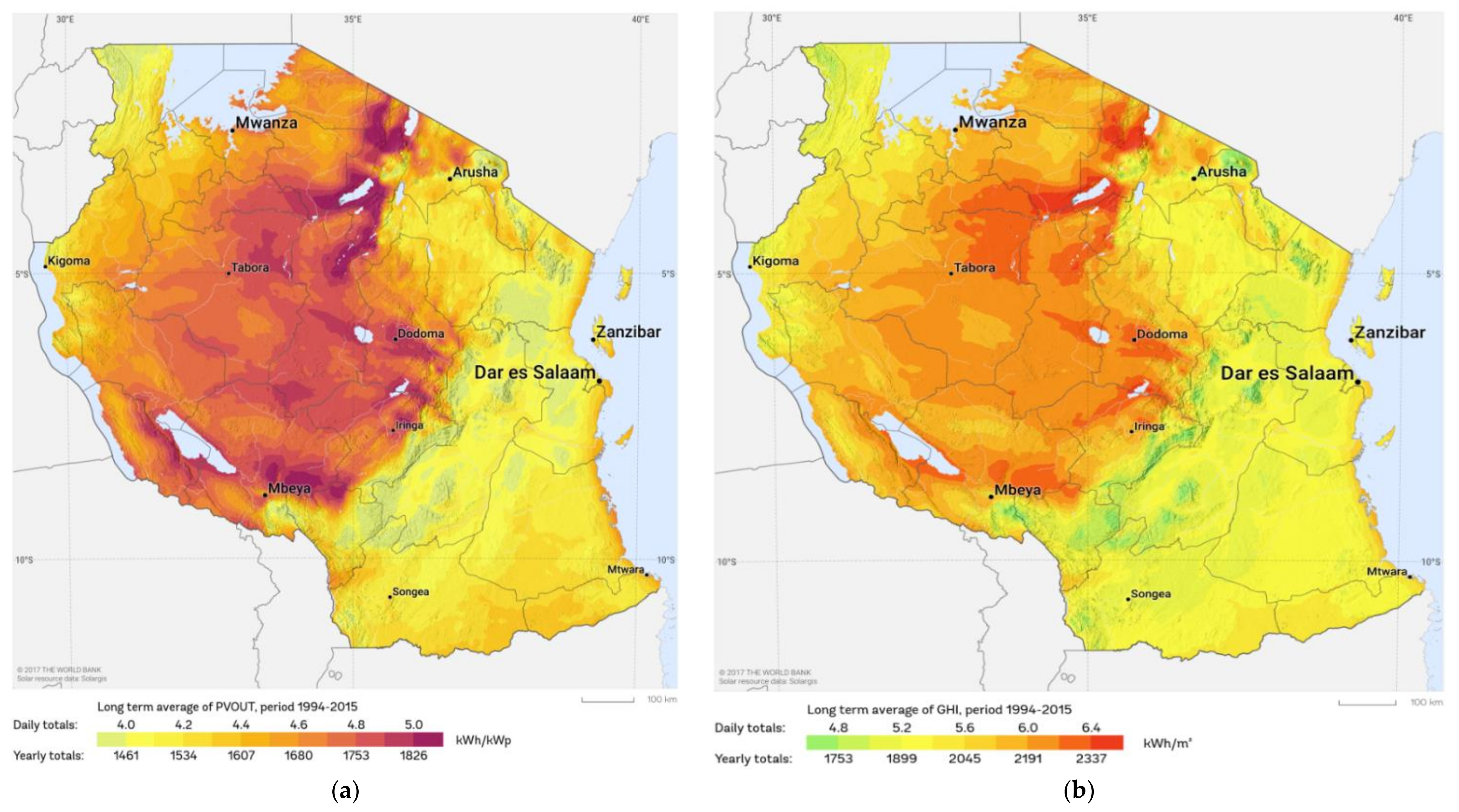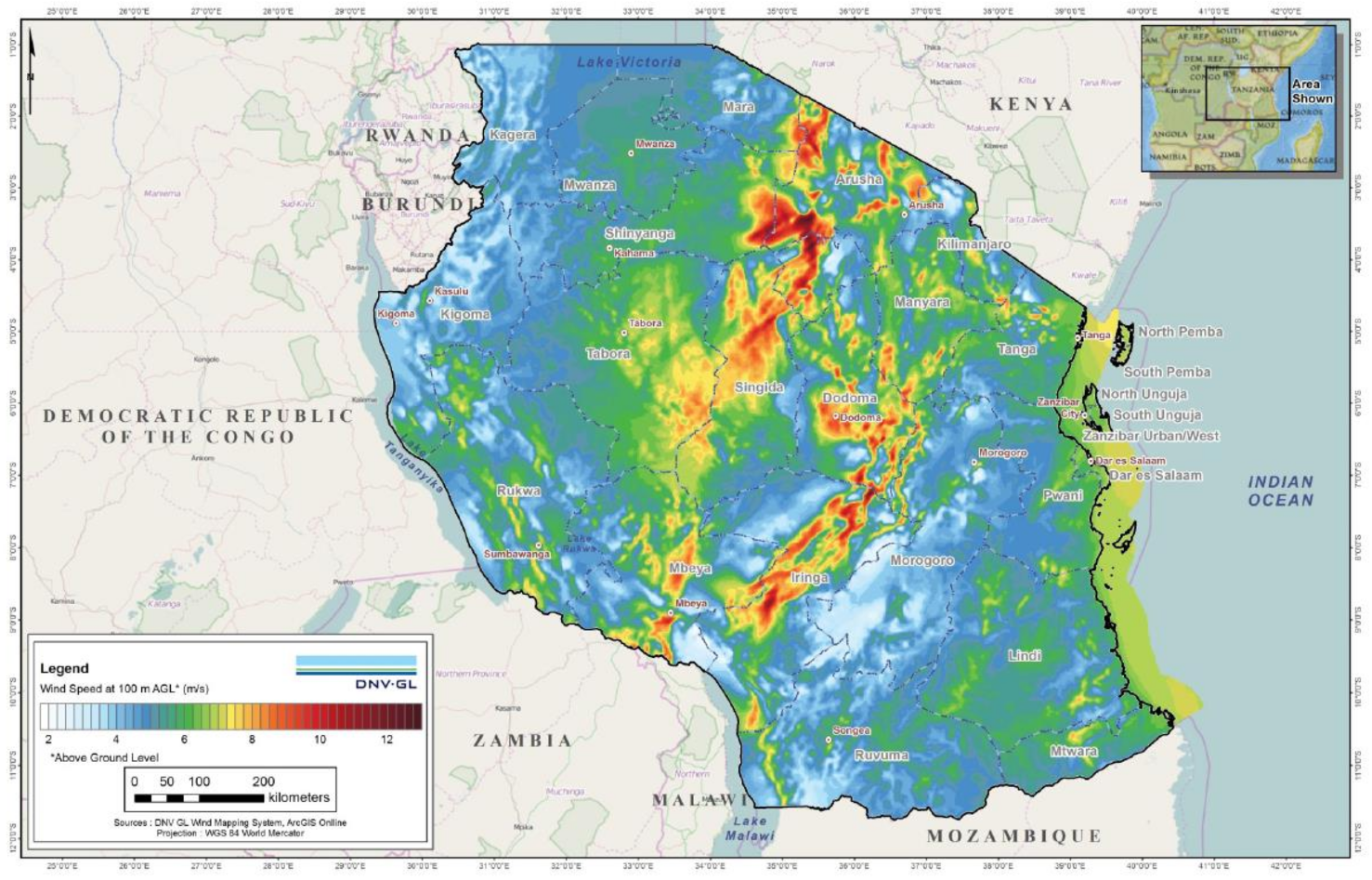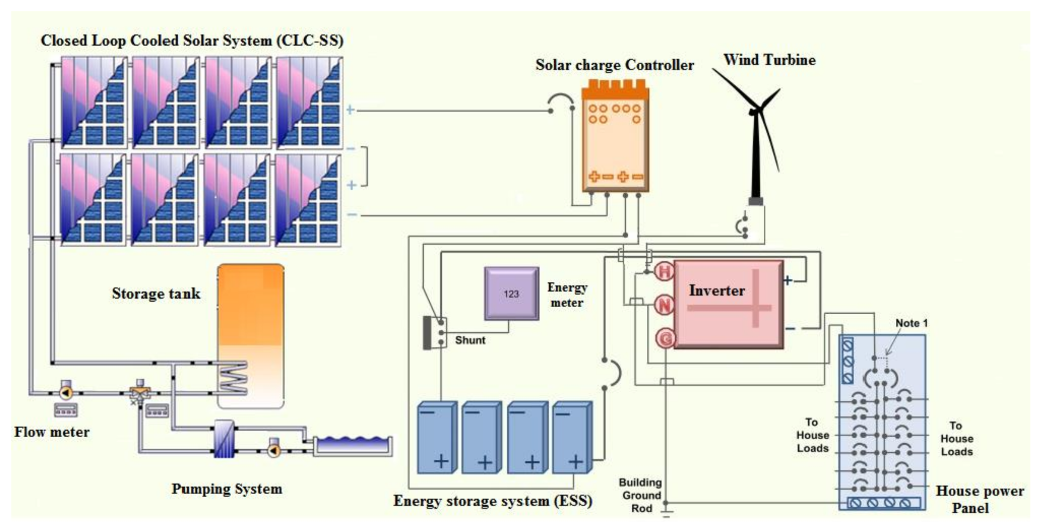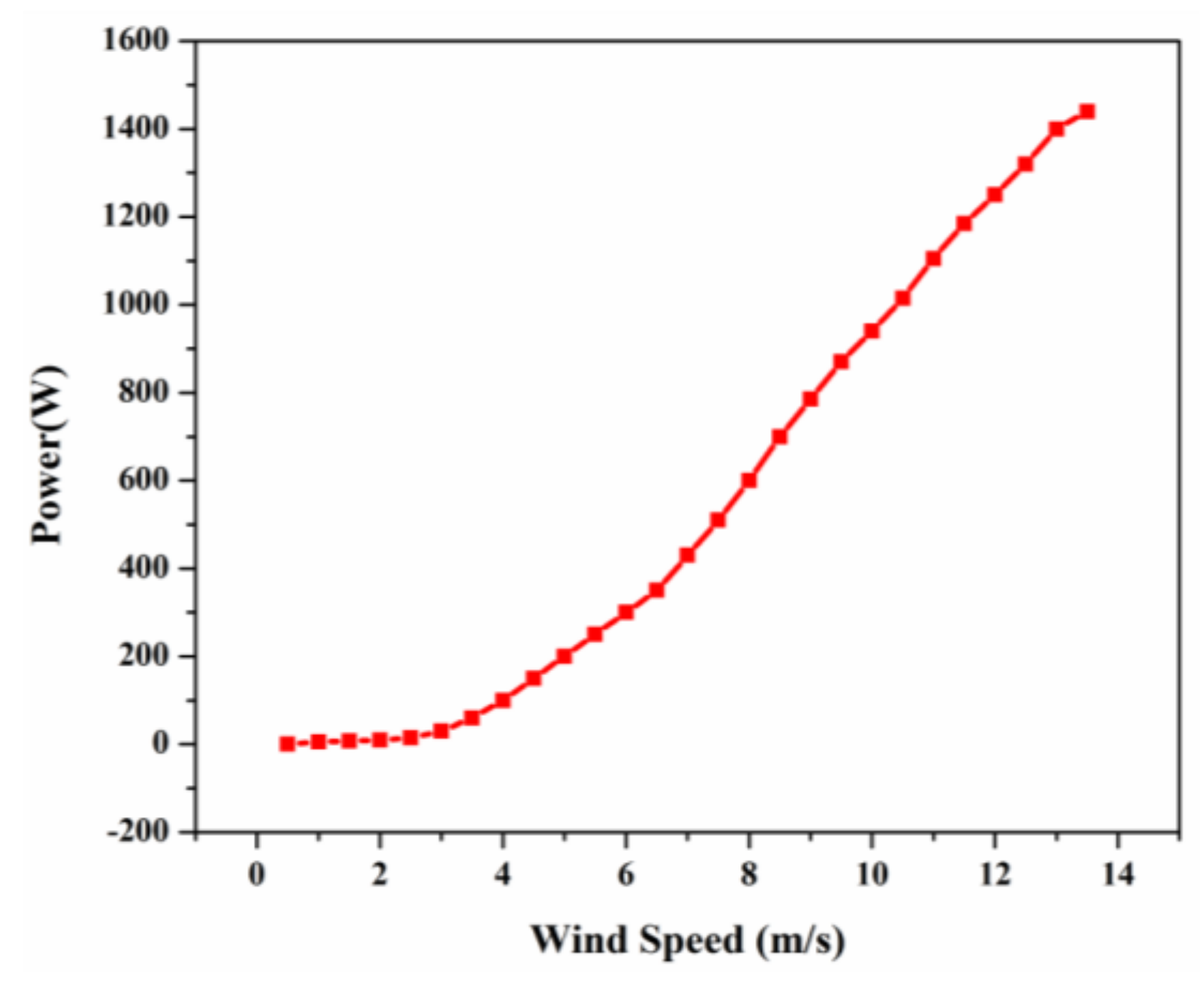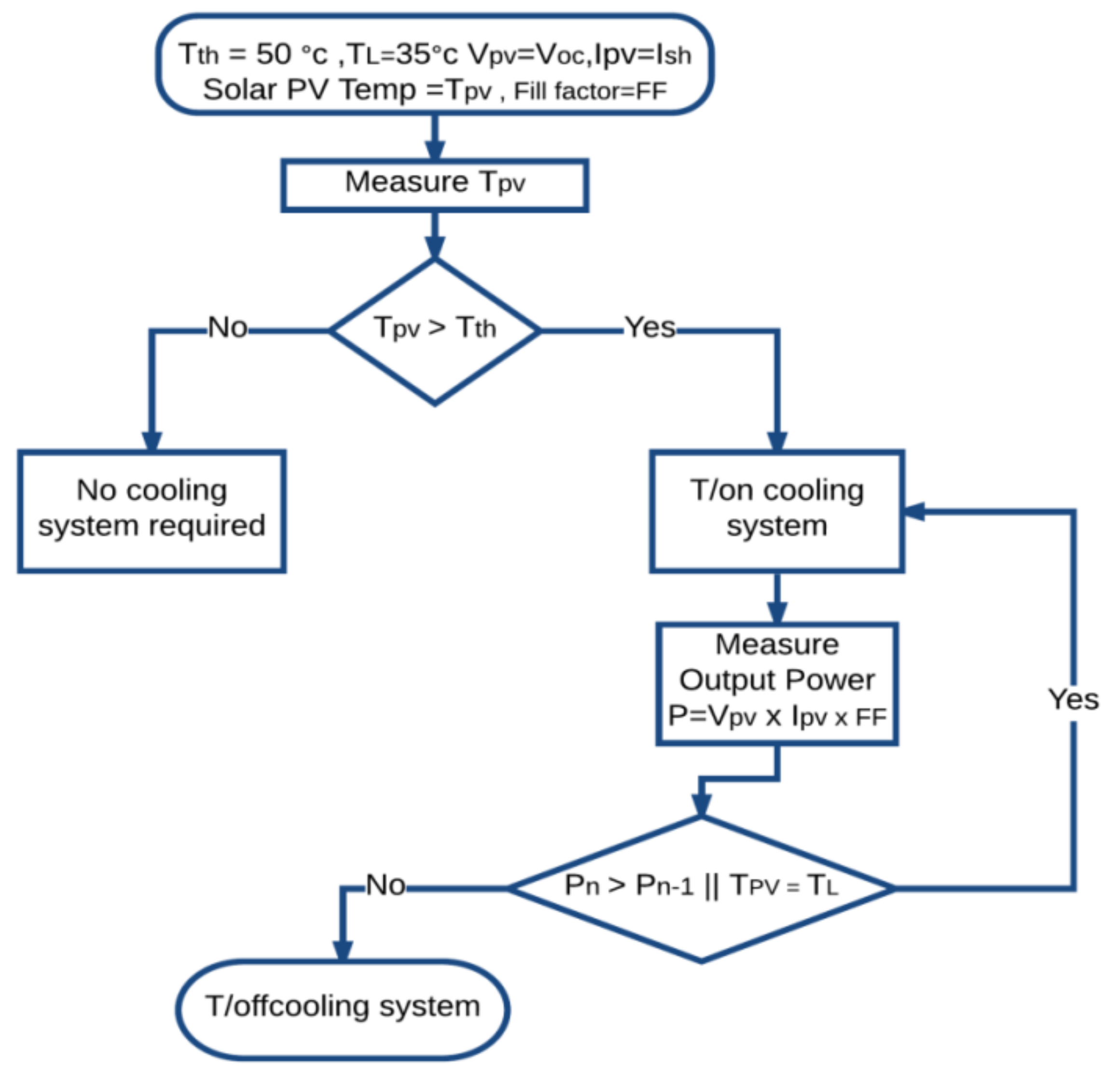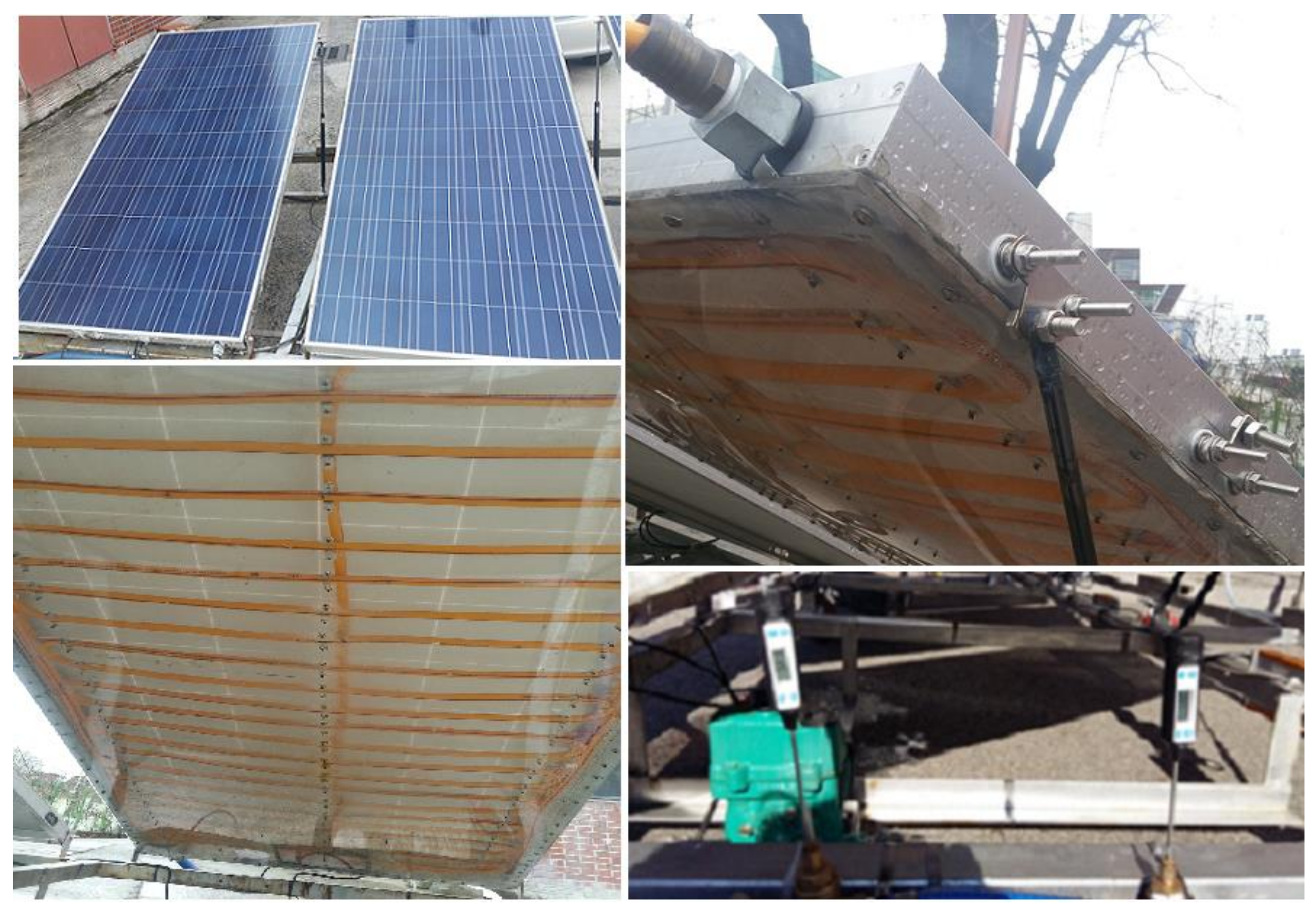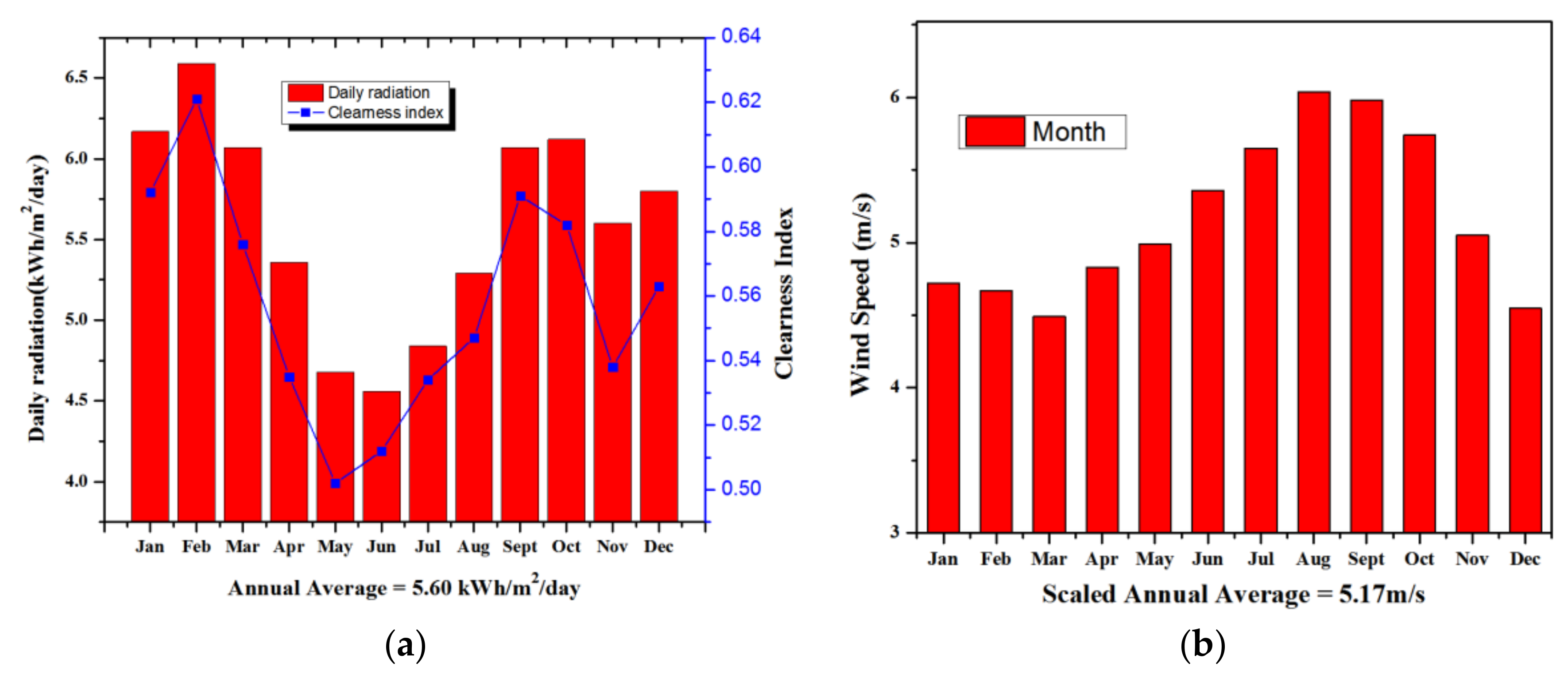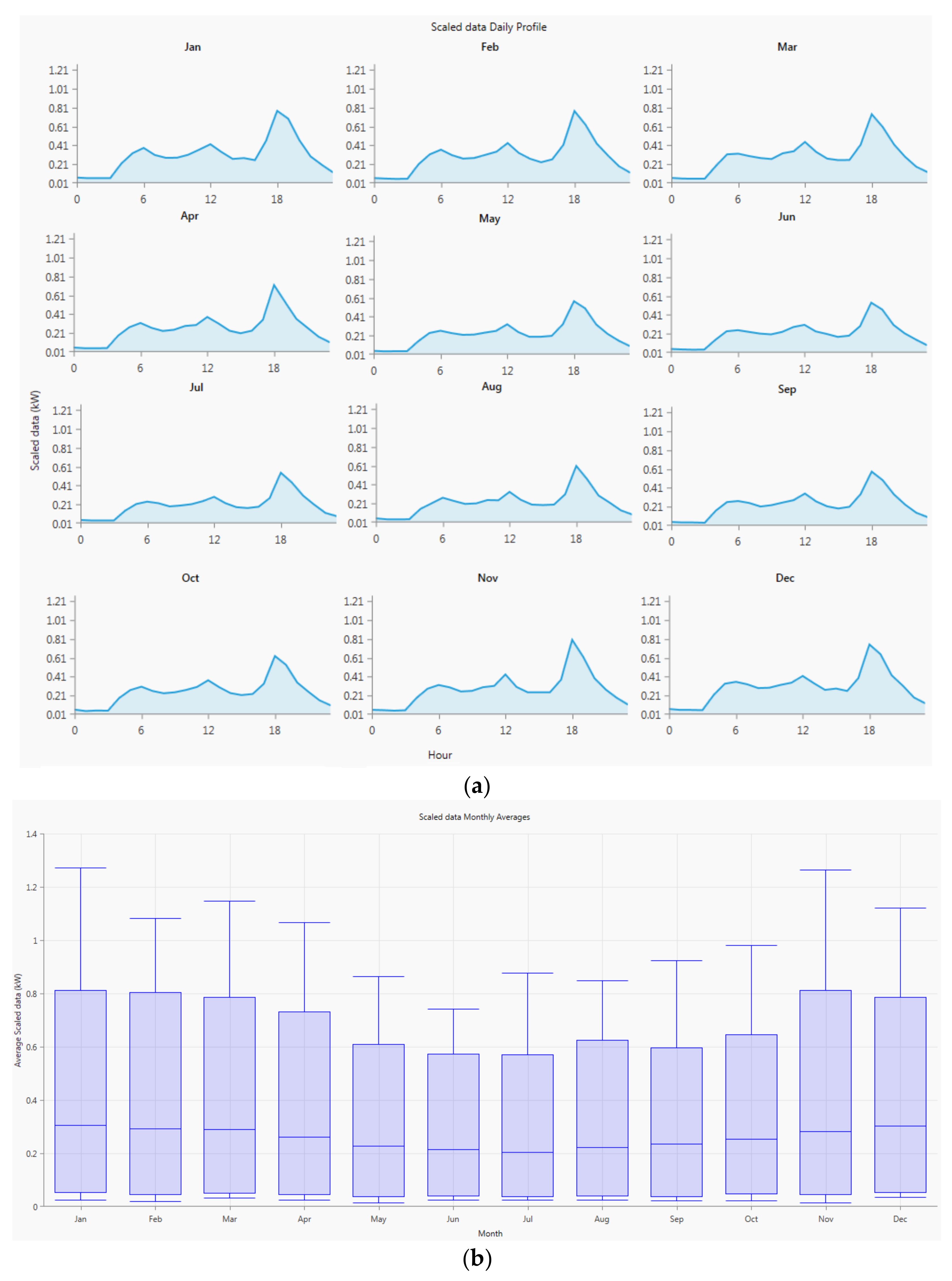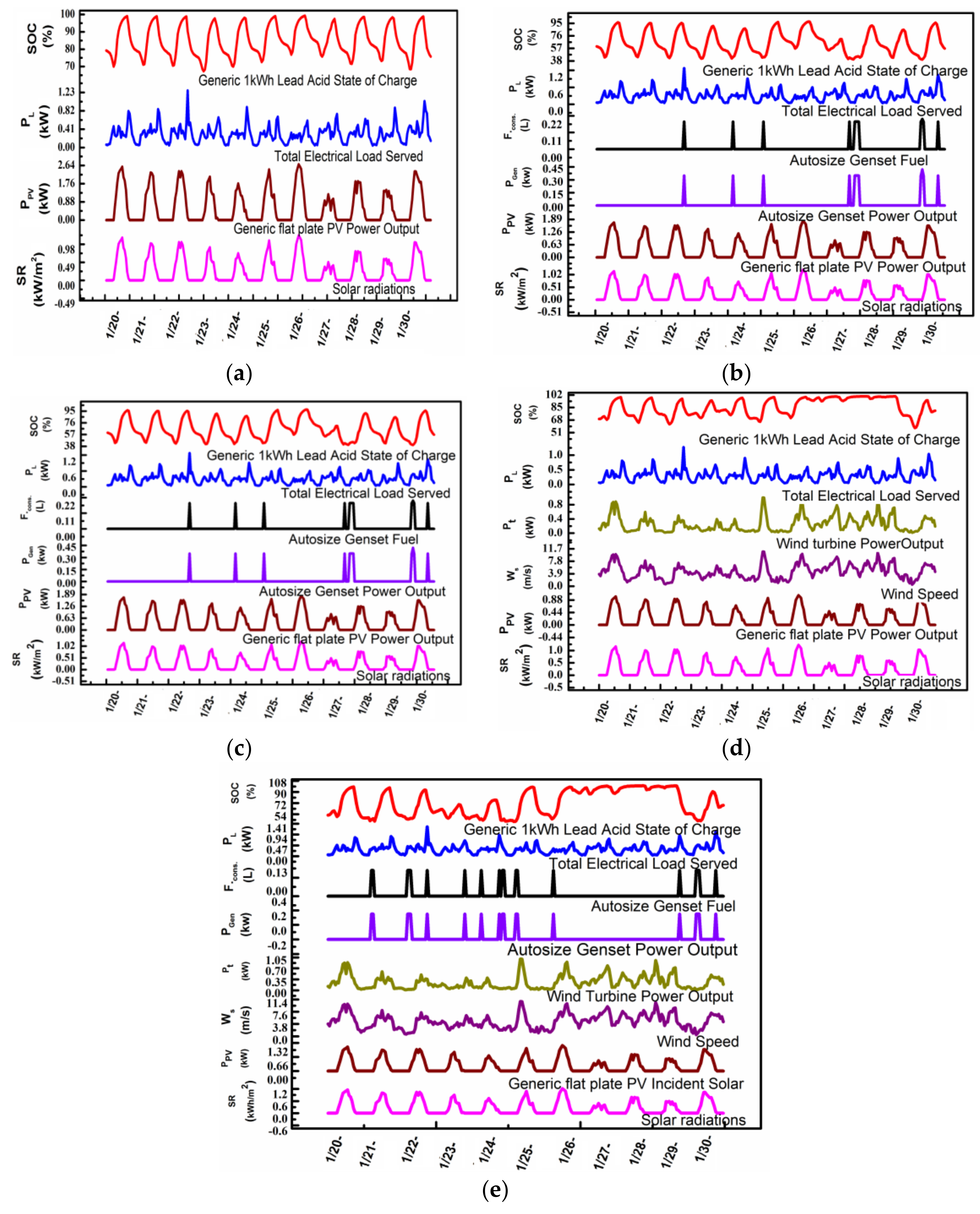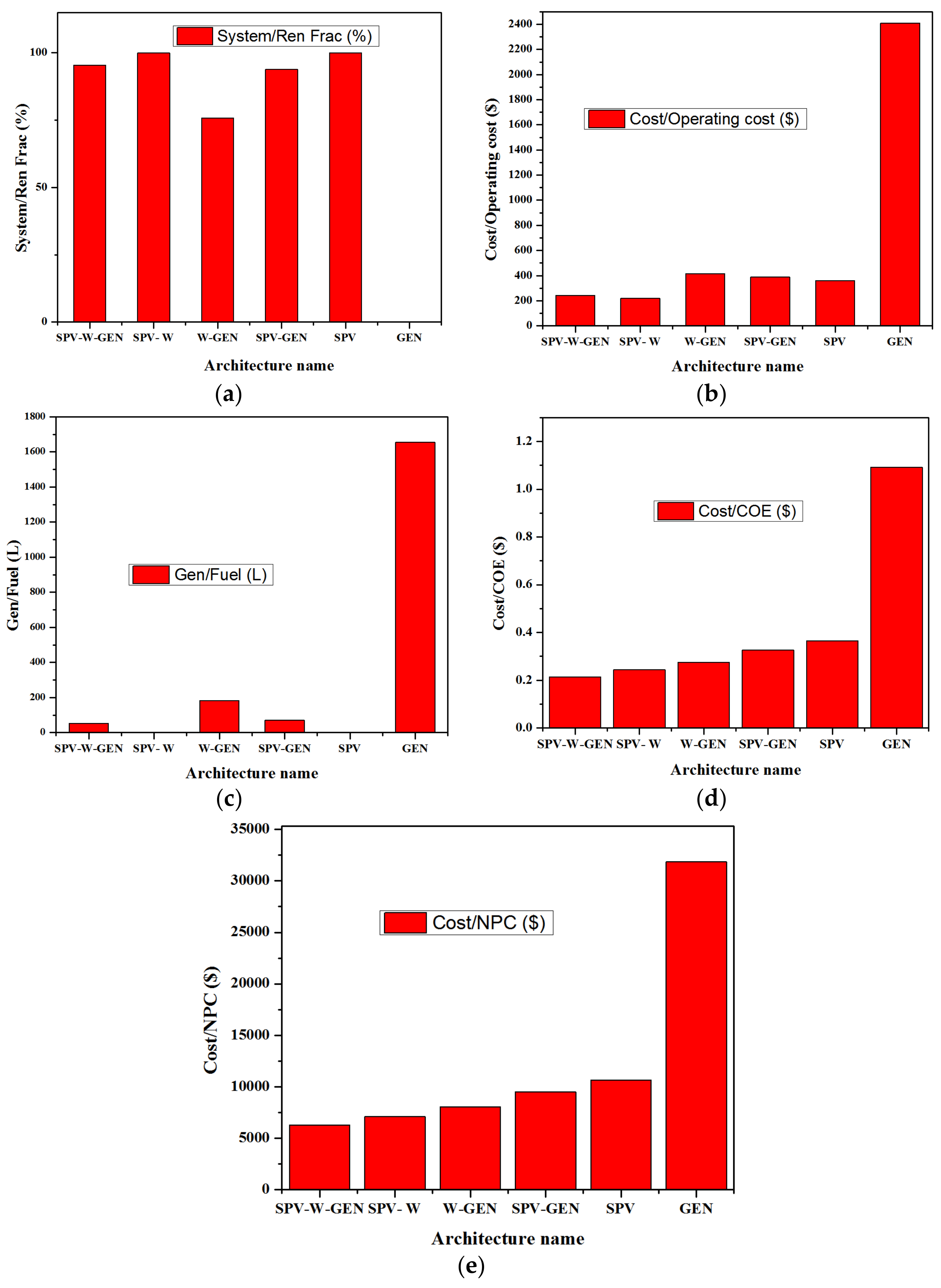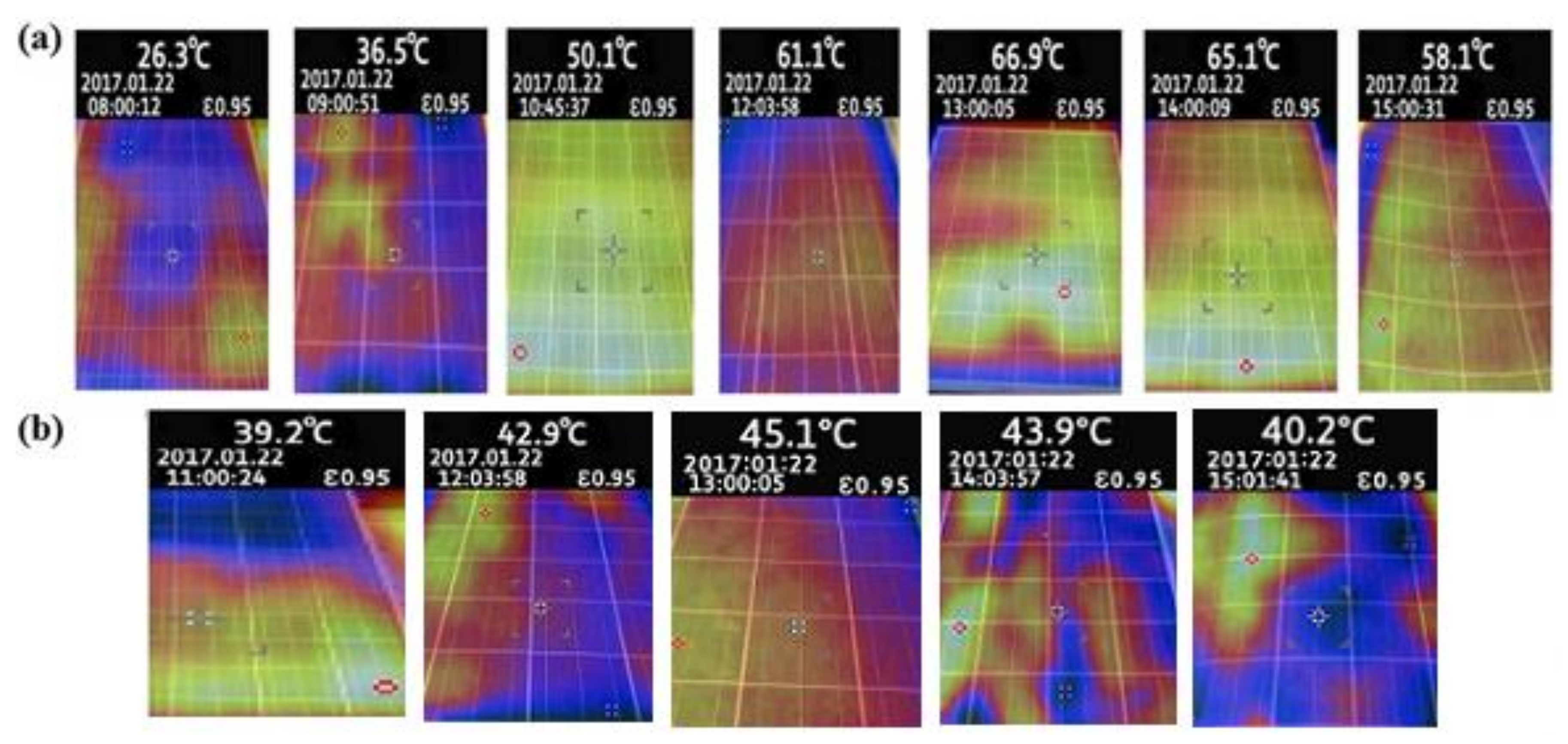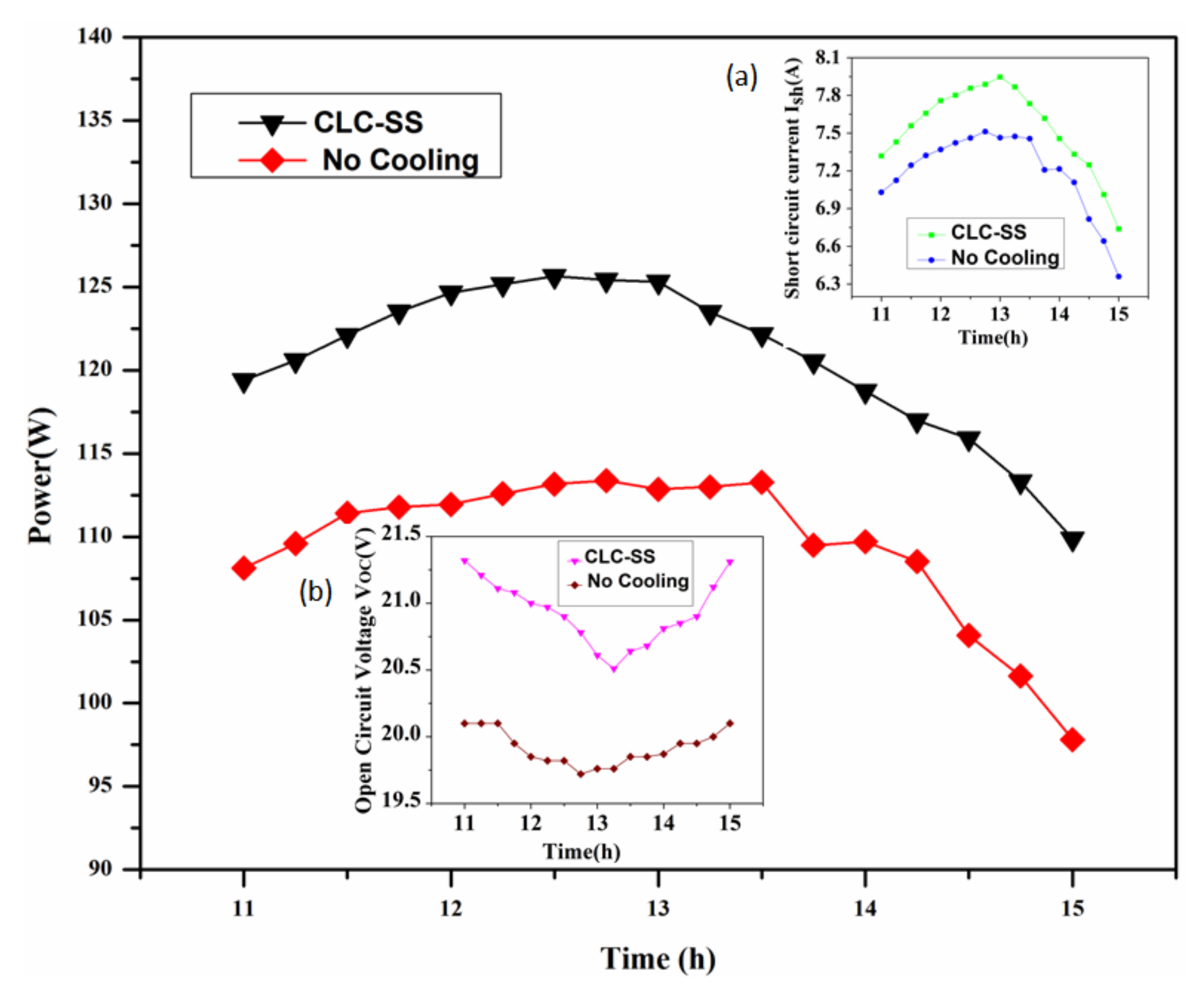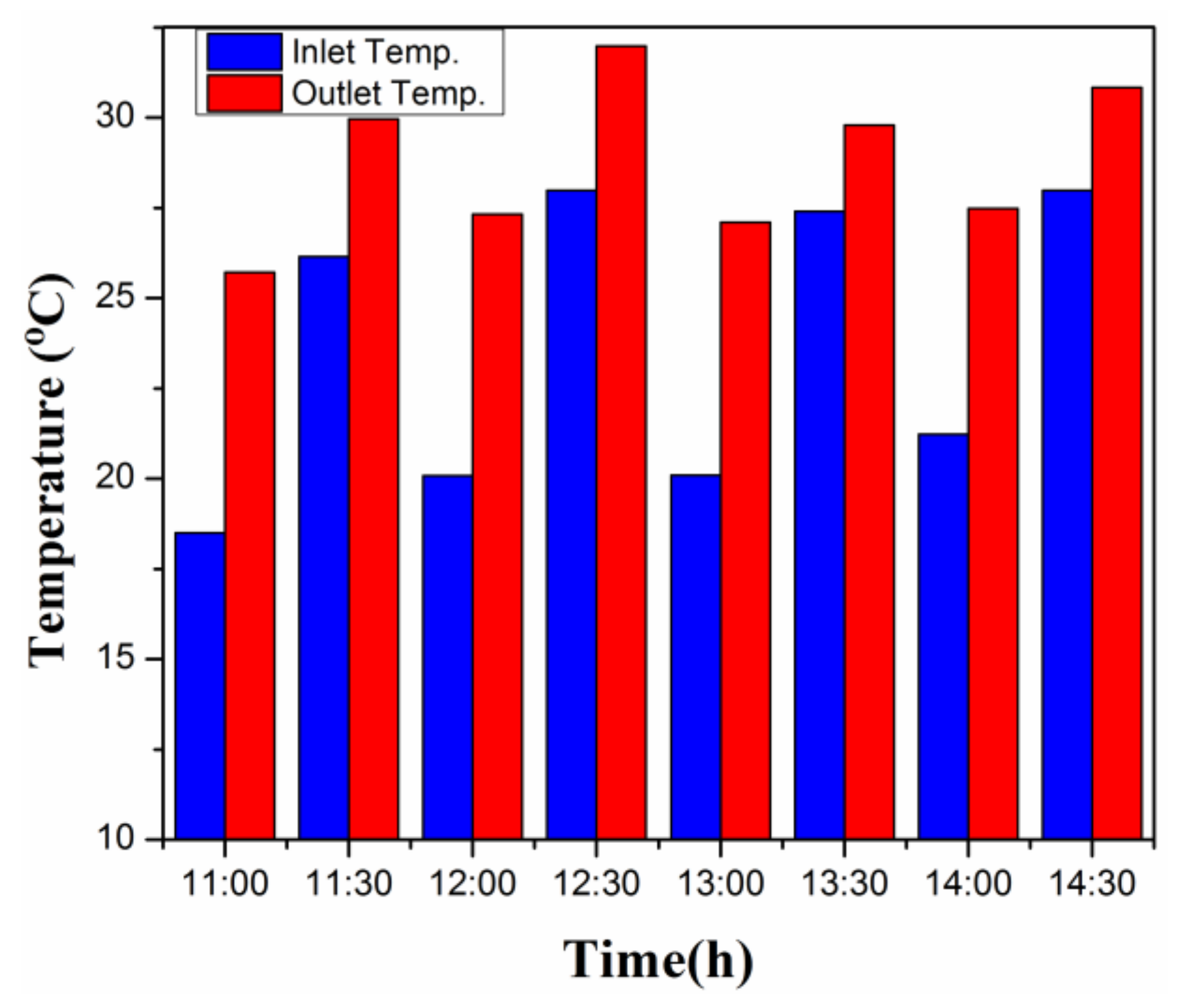1. Introduction
In the modern era, there is an increasing need to utilize renewable energy resources (RES) due to the depletion of conventional energy resources (CER). Moreover, CER are causing environmental pollution [
1]. Energy is essential to social and economic growth and advances the quality of life [
2]. Like most developing countries the main barrier to economic progress in Tanzania is low electrification. Nevertheless, the number of houses in rural areas connected to the national grid has increased significantly over the last half-decade. In [
3], approximately 16.9% of rural households in Tanzania mainland were connected to different forms of electricity, which is much lower than the 65.3% of their equivalents in urban areas. The statistical data shows that the highest proportion of households connected to the grid was Dar es Salaam (75.2%) followed in order by Njombe region (50.5%), Kilimanjaro (42.6%), and Katavi (40.0%). Nevertheless, there are still areas with less than 20% access to electricity, such as Kigoma (16.2%), Songwe (15.9%), Geita (14.0%), Shinyanga (12.8%), Rukwa (8.7%), and Simiyu (11.5%), as presented in
Figure 1.
Tanzania has a high RER potential owing to its geographical position, i.e., global solar radiation and amount of wind. Over the last two decades, in Tanzania, the energy consumption has been improved considerably due to economic growth. On the other hand, because of improper future planning, an impressive energy policy is required to achieve sustainable development [
4]. Fossil fuels are used as the main source of energy and sidelining with RES, i.e., wind and solar resources, comprising a very small component [
5].
According to Tanzanian official generation expansion plan 2035, the dependency on fossil fuel is high, which highlights the lack of research on integrating renewable energy technologies [
6]. Owing to increase in the population of Tanzania, installing electric grids in remote areas is expensive and not feasible [
7]. The demand for HES is progressing gradually around the world due to the easy and quick installation [
8]. Recent research indicates that if the RER are properly optimized, they can act as efficient power sources similar to fossil fuels [
9]. Diesel-battery-PV, PV-wind-diesel, etc., can be utilized as hybrid energy system [
10]. The RER-based HES can be installed quickly and easily, improving the quality and reliability of energy systems [
11]. In addition, the power generation capability of the solar based hybrid energy system can be increased using a cooling system [
12]. The temperature of PV cells and the conversion efficiency dependency is calculated in [
13]. Research has shown that with every 1 increase, the efficiency of an amorphous silicon solar cell decreases by 0.05%; similarly, the reduction varies from 0.4 to 0.5% for a crystalline silicon solar cell [
14]. The performance of solar systems can be enhanced using a cooling system. However, the main challenge is to propose an efficient cooling system [
15]. In the literature, various solutions have been proposed to minimize the operating temperature of solar PV system [
16]. In [
17], thermal solar/hybrid PV system is analyzed. The cooling system was attached to the PV panel’s rear side of the module. Comparative assessment of four different cooling systems for Tanzania weather conditions has been studied in [
18].
Extensive research has been conducted on the solar wind hybrid energy system, however, less attention has been given to real field conditions where most often the temperature of the solar PV module is greater than defined at standard test conditions. In general, the net power contributed by the solar PV system in solar-wind HES is lower than expected in countries near the equator with hot weather such as Tanzania, Kenya Udanga, and Somalia, etc. This leads to a lower user satisfaction and trust in renewable energy systems. This research proposes a novel hybrid solar wind hybrid energy system with a closed loop water cooling system. The CLC-SS is included in the HES for two very interesting reasons i.e., (1) to increase the net output power delivered by solar PV modules in the HES by cooling them to an optimal temperature range; (2) To utilize heated water generated by the temperature rise due to heat absorption from the PV module for performing useful daily activities with some auxiliary heating system. This approach of cooling solar PV modules will reduce the cost of electricity due to enhancement in electric power without high investments and also with save some power required to heat the water. To find an optimized solution, this study performed a number of simulations. The proposed solution was derived using wind and solar resources of the area and optimized using HOMER software with real-time experiments [
19]. Furthermore, a prototype of the proposed solution was also installed on-site. The unique solution proposed in this research is equally applicable for improving electrification rate in rest Sub-Saharan Africa (e.g., Ethiopia, Ghana, Uganda, Zambia, Togo Somalia, Rwanda, Chad, etc.) and developing countries around the world with similar temperature conditions. The remaining of this paper is structured as follows:
Section 2 discusses, describes, and elaborates the comprehensive overview of the methodology for investigating an optimized solution. Performance evaluation is carried out in
Section 3.
Section 4 concludes this paper along with a brief proposal for future work.
3. Results and Discussions
The daily solar radiation and wind speed data was collected from National Aeronautics and Space Administration (NASA) and National Renewable Energy Laboratory (NERL) and on-site weather stations. An evaluation of solar insulation on horizontal surfaces was performed using Angstrom Correlation and Arusha’s daylight time data. Like all of Tanzania, Mbuguni also receives a large amount of solar radiation (kW/m
2/day) every day. The amount of solar radiation varies during different months of the year; with January, February, March, September, and October having a higher level of solar radiation than the average annual daily radiation: 6.17 kW/m
2/day, 6.59 kW/m
2/day, 6.07 kW/m
2/day, 6.07 kW/m
2/day and 6.12 kW/m
2/day, respectively; and May, June, and July having comparatively less radiation (4.68 kW/m
2/day, 4.56 kW/m
2/day and 4.84 kW/m
2/day, respectively). August, November, and December receive approximately 5.29 kW/m
2/day, 5.60 kW/m
2/day and 5.8 kW/m
2/day, respectively, which is similar to the mean values of the year. The average solar radiation at each month is shown in
Figure 9a. The wind speed (m/s) of Mbuguni is moderate and good enough to generate a significant amount of electricity using wind turbines. In contrast to the daily solar radiation of each month, Mbuguni have good wind speed in June, July, September, and October. Monthly average wind speed is given in
Figure 9b.
Most houses in Tanzania/Mbuguni have very little use of electricity except for charging mobile phones, watching television, lighting their houses, electric fans for cooling, and for water pumping motors. An average scaled annual load of 6.180 kW/day and the scaled peak load of 1.2722 kW with a load factor of 0.2024 was considered for the analysis, design, and selection optimal energy system for this area (Mbuguni/Arusha). The variations of load occur during different hours of the day and night, also varied with the different months of the year with January and February showing comparatively more power consumption and June and July showing comparatively less than the average electricity consumption within each month.
Figure 10a,b show the average scale daily and monthly consumption, respectively. The average scaled annual daily loads selected were sufficient to provide electricity for the operation of these household activities.
3.1. Investigating Appropriate Architecture/Structure
HOMER can design optimal composite RER with many hourly simulations performed repeatedly by the software. The numerous values for wind speed, solar radiation, diesel cost, and minimum renewable fraction were considered to perform these simulations. The HOMER Optimizer
® (Pro 3.11, HOMER Energy, Boulder, CO, USA) uses a trademarked derivative-free algorithm to search for the least-costly system. HOMER then displays a list of configurations, sorted by net present cost (sometimes called life-cycle cost), that can be used to compare system design options. For Mubuguni weather conditions, HOMER performed 10,648 simulations suggesting 5324 optimization cases arranged in ascending order of low net present cost. Diesel generators (DGs) were not part of our proposed HES, however, DGs were initially considered for HOMER analysis and comparison (as HOMER considers DGs as base case for cost estimates). Specifications and fuel cost for generator are provided in
Table A1 (
Appendix A). Based on the optimized system suggested after a brief analysis of local renewable resources by HOMER, five different configurations were considered as comparative and optimized solutions: (1) solar-wind-generator HES (SPV-W-GEN); (2) solar PV system (SPV); (3) solar–wind hybrid (SPV-W); (4) solar-generator HES (SPV-GEN); and (5) wind-generator (W-GEN) as depicted in
Figure 5. All five systems were off-grid and the size of the system was optimized in such a way that all the energy generated by the systems used served the electrical load of houses, where these systems were installed to avoid any expenses related to grid expansion. Comparative analysis was performed by comparing the outcomes of these five systems with the base system comprised of a generator serving the load
Table 5 depicts the analysis of different architecture with corresponding solar, battery, wind turbine, converter system, and DG required for each architecture.
The total amount of power delivered by the solar PV system, wind turbine, and auto size generator within these five structures (SPV-W-GEN, SPV, SPV-W, SPV-GEN, and W-GEN) in contribution to serve the total electric load was measured at the experimental location as presented in
Figure 11. In the case of the SPV system, the entire load was served by the solar panel proposed in the architecture (3.36 kW). The lead-acid batteries state of charge (SOC) depends entirely on the amount of power provided by solar panels or the load served by these batteries in the case of no or low power from the solar panels. A large number of solar panels and lead-acid batteries (16 nos. in the case of SPV) are required because the amount of power generated in the SPV architecture is only due to the solar panel and its quality depends on the solar irradiance available, i.e., no power generation before sunrise and after sunset or less power generation on cloudy and least sunny days. Maintenance of the battery is also a bottleneck for the widespread adoption of this architecture. In the case of the SPV-W-GEN, SSPV-GEN, and W-GEN architectures, the load served by these architectures is contributed by the generator along with the other RER, i.e., solar and wind, and requires the continuous availability of fuel (diesel) whenever the generator is operated in these architectures to serve the load. The amount of power delivered by an auto size generator along with fuel consumption (L) in any of architectures as shown in the
Figure 11. The transportation of fuel to the remote area of Mbuguni (Tanzania) is challenging and also it causes serious environmental pollution. SPV-W, on the other hand, does not require any generator to serve the load, and it requires a smaller number of lead-acid batteries (10 nos.) than SPV (16 nos.). The battery SOC depends on the power delivered by both the solar panel (
) and wind turbine (
) and the load. Wind power is even available when there is little or no solar irradiance. The wind speed in Mbuguni helps generate a considerable amount of power using a wind turbine. All the systems were designed keeping in view an interrupted availability for power. For example,
Figure 11b confirms the uninterruptible power supply by the designed solar wind HES. The
Figure 11b shows that the power required for the analyzed load (6.18 KWp) is always available. The uninterruptible availability of power can be easily assured from the battery SOC. Even if there is insufficient solar or wind power, the SOC of the energy storage system (battery) never drops to the threshold value (discharge depth: 15%) and a sufficient amount of net power can be used even at peak load.
3.2. Economical Comparisons
An assessment done by HOMER showed that SPV-W-GEN, W-GEN, and SPV-GEN offer 95.40%, 75.78%, and 93.86% renewable penetration, respectively
. SPV-W and SPV offer 100% renewable penetration and are very economical while the base system of GEN is the worst with 0 renewable energy penetration as depicted in
Figure 12a. The operating cost of the base system (GEN) is too high (
$2409.94) to be selected as the source of electricity for the local community of Mbuguni. The operating cost of SPV-W-GEN, W-GEN, SPV-GEN, and SPV are
$239.86,
$413.81,
$388.90 and
$359.30, respectively (see
Figure 12b). The operating cost of the SPV-W (
$218.952) was least of all the systems considered. The fuel cost of all these systems was analyzed: SPV-W-GEN, W-GEN, SPV-GEN, and GEN were 52.42 L, 183.32 L, 69.92 L, and 1654.39 L, respectively as illustrated in
Figure 12c. SPV-W and SPV are 100% percent based on renewable and do not require any fuel for their operation. This advantage makes them superior over the other methods. The COE for GEN is 1.09238, which is much higher than the rest. The COE of SPV-W-GEN, SPV-W, W-GEN, SPV-GEN, and SPV are
$0.21467,
$0.24394,
$0.27541, and
$0.32599, respectively as elaborated in
Figure 12d. The net present cost (NOC) for SPV-W-GEN, SPV-W, W-GEN, SPV-GEN, SPV, and GEN are
$6259.86,
$7110.53,
$8031.25,
$9505.97,
$10,638.53, and
$31,854.57, respectively as shown in
Figure 12e.
Based on the obtained results of
Figure 12 from HOMER analysis, SPV-W, which requires low operating cost and no fuel consumption, 100% percent renewable penetration, and low COE, was selected as a good and feasible HES considering the weather conditions of Mbuguni.
3.3. Analysis of CLC-SS
A closed loop cooled solar PV system is an essential part of HES proposed for Mbuguni weather conditions. Therefore, a comparative assessment was performed to determine the effect of cooling system. The proposed cooling system (
Section 2.2) was examined using real-time experiments performed on the same day and time to obtain authenticated data for the temperature, open circuit voltage (
), and short circuit current (
). Initially, only the data from the solar panel with no cooling was monitored from 8:00 a.m. to 10:30 a.m. at specific time intervals while the CLC-SS was turned OFF. Temperature of panel with no cooling
was 28.3 °C at 8:00 a.m., which kept on increasing with passage of time until it reached 66.9 °C at 1:00 p.m. (13:00) as shown in
Figure 13a. At this instant (1:00 p.m.),
was 42.1 °C more than the STC (25 °C). At 10:45 a.m.,
reached 50.1 °C and CLC-SS was turned on. PV module with Closed-loop system (C-LS) reduced the temperature (
) to 39.2 °C (as per data recorded on 11:02 a.m.). Closed loop water circulation tried to lower the panel temperature. However he
continued to increase until 1:57 p.m. At 1:00 p.m., the
was 45.1 °C (
Figure 13b). The
decreased to 43.9 °C at 2:03 p.m. and decreased to 40.2 °C at 3 p.m. Important data for system with no cooling and C-LS summarized in
Table 6.
We then compared the data collected for output power,
and
values for CLC-SS and conventional solar system with no cooling system attached.
Figure 14 exhibits that the maximum output electric power extracted from the PV module with no cooing and CLC-SS was 113.39 W and 125.66 W, respectively. The average power delivered by the solar PV module with no cooling, and C-LS noted over a time period of 11:00 a.m. to 3:00 p.m. was 109.55 W, and 120.75 W, respectively. Percentage increase in average output power of the CLS-SS was 10.23%.
and
curves for both systems as inset graphs. The top left inset graph (a) shows the
curves for both the arrangements. The
values for the solar panel with no cooling from 6.64 to 7.03 A between the time interval from 11:00 a.m. to 3:00 p.m., with maximum values within the time interval between 12:30 p.m. and 1:30 p.m. The
values for the CLC-SS ranged from 6.73 to 7.94 A between 11:00 a.m. and 3:00 p.m. The middle down Inset graph (b) reveals that the
decreases with increase in temperature. The lowest values for
were observed between 1:00 p.m. and 2:00 p.m. The
for the CLC-SS was in the range of 20.51 V to 21.32 V. The out power,
and
curves reveals better performance by CLC-SS than conventional solar system.
An increase (10.23%) in the output power of the CLC-SS is recorded. In addition, it also offers an increase in temperature of outlet water (the experimental setup shows an average increase of 5.09 °C as depicted in
Figure 15). The water with enhanced temperature along with some auxiliary heating mechanism can also be used for some very useful daily activities. DC/AC electric power is required to run this motor (a 15 W pump was employed in CLC-SS during this experiment). The power required by the motor to circulate water through the pipes can be compensated by conserving power to heat that amount of water. In addition, the space required for discretely installing a solar wind hybrid system and a solar water heating can easily be reduced by installing CLS-SS-Wind HES with an auxiliary heating system. Results of
Section 3.3 illustrate that the cooling system CLC-SS has a definite effect on the yield of PV modules within the HES.
Based on this research, a real-time prototype HES comprised of a solar PV system integrated with closed loop cooling system and wind turbine was installed at Star Secondary School, Mbuguni, Tanzania (
Figure 16).
4. Conclusions and Future Work
In this paper, an uninterruptible and environmentally friendly CLC-solar wind HES is designed and optimized for a remote area of Tanzania. The closed loop cooling solar system (CLC-SS) helps to extract more power from PV modules within HES (10.23% for our experimental study). However, continuous operation of cooling system is not recommended and requires to follow the controlled algorithm proposed in this paper. Moreover, detailed simulations were performed by HOMER software considering the manufacturing cost and efficiency for derivation of optimized values of solar PV, wind turbine, converter, battery size and quantity utilizing solar and wind resources of the considered location. The results also authenticate, that the cost of energy (COE) of the optimized system was 0.26 $/kWh and the net present cost (NPC) of the optimized system was $7110.53.
An improved output power solar wind HES designed in this research is cost-effective and can be adapted easily as a future green energy system, predominantly in countries with low electrification rate and high annual solar radiation and hot weather compared to the STC defined for a solar PV system. However, in the near future, some more convenient renewable energy models and appropriate cooling systems can be introduced into the HES, allowing the HES to be adopted across the globe.
